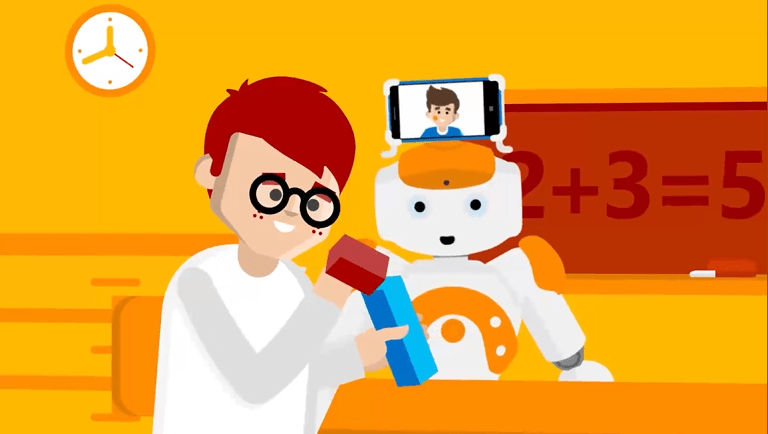Artificial intelligence is both today’s ultimate breakthrough technology and a bit of a buzzword. It is, however, changing many facets of our lives, some of them quite noticeably. Whether AI is applied in business, industry, healthcare or education, it is often used as more or less an umbrella term, meaning that a product or system has something to do with big data, machine learning, pattern recognition and cognitive analysis, natural language processing (NLP), computer vision, neural networks, and so on.

Individually or combined, these aspects of artificial intelligence proper can power a variety of tools, educational aids, and digital learning platforms. Their main objective is to assist, augment, and streamline the traditional classroom experience without necessarily disrupting its core processes (so no “sentient robots to take teachers’ jobs” or “artificial intelligence to replace educational systems” here, sorry).
With that in mind, here are four examples of real-life applications of AI changing the classroom, from established projects to soon-to-be-reality initiatives.
1. Voice assistants as teachers’ allies
The idea to apply voice assistants as teachers’ aides is nothing new—after all, the “assistant” part of the label defines their purpose rather unambiguously. Based on NLP, speech recognition and generation technology, virtual assistants are perhaps the most noticeable ‘AI-infused’ presence in our lives. Mostly associated with smart home and personal devices, they are soon believed to become no less than expected presence in classrooms, especially in primary schools.
Spelling and reading assistance, classroom activity management aids, and reference desks are the most common use cases at the moment. With the development of third-party app ecosystems around Alexa and other smart speaking tech, the role of voice assistants as limited but indisputable classroom allies is only to be expanded to the areas of learning foreign languages, resource searching, reference checking, and others.
While the concerns about potential privacy infringements still exist, they are not as prevalent as in the case of visual recognition and surveillance systems, possibly due to more exposure and prominent everyday use of voice tech in various settings.
2. Advanced facial recognition for attendance roll marking
A star pupil of the computer vision class, automated facial recognition (FR) has been long used in surveillance systems around the globe. Lately, it has gained a lot of extra traction thanks to leaps in development and growing accessibility of the technology. Integrated by government and commercial facilities, tech giants, and online retailers, by now FR has found widespread success as an extra layer of digital security, a convenient privacy feature, a social media and marketing tool, and more.
So, it was only a matter of time before this technology found use in schools, libraries, and campuses. Among other examples, the last two years have seen massive trial rollouts of FR systems for automated attendance school roll marking, like the one in Australia. Initially sparking privacy-related worries, the system works under the strict Privacy Impact Assessment rules, and requires explicit consent from students and parents to store images.
While the more controversial recent cases of biometric face scanning surveillance in school districts (but not classrooms) in the US aim to address security issues first and foremost, the Australian model prioritize saving skilled teachers' time via the automation of a routine menial task. Delegating attendance roll marking to a FR system not only allows teachers and students in more than 100 Australian campuses to use class time more effectively, but also saves additional staff hours eliminating the need to cross-check attendance.
Without changing in-class experience per se, this technology adds convenience and helps everyone involved to better focus on the learning process.
3. Emotional and movement monitoring for better classroom dynamics analysis
Automated attendance checking is a timesaver, but there are other uses for an AI-powered camera. In the same short span of two years, several unrelated but similar AI-based projects have been put to trial in different corners of the globe—to track movements and monitor students’ facial expressions during classes.
Aside from the obvious purpose (like automated exam supervision), the goal of these systems is to better assess involvement and progress of students, individually or as a group. The system can recognize and score how students’ respond to different information and methods of teaching, when they tend to space out, how readily they collaborate, work alone, or get distracted, and so on. It also helps assess and give pointed feedback to teachers on their methods.
In theory, the educational process then can be adjusted and further personalized based on the gathered information, to lessen stress and improve engagement, aiding teachers and students to give and acquire knowledge to the best of their abilities. In practice, though, the matters might get a little more complicated in a broader, sociological context.
Needless to say, these types of initiatives spark not only acclaim and support, but broad debates—like in China, where several of these programs have been integrated in schools of different provinces to the polarizing public response. In tow with the expected Orwellian concerns, the lack of regulations as well as of a steady history of positive outcomes add to the general uneasiness in public discourse.
Despite its early days and the standards and limitations that are yet to be figured out, the global-wide interest in and trials of similar tech can mean that emotional and movement monitoring in education is here to stay.
4. Automated data analytics and cognitive insight for complex solutions
The students of today are digital natives. Though this doesn’t necessarily translate into digital literacy, it still means that for them the personalization, augmentation, and at least partial automation of the classroom experience is nothing less than expected. What AI consultants call a ‘customer experience-centric approach’ in business is becoming true for digital learning platforms, as well.
Providing visual tools to monitor students’ progress and gathering statistics, these software platforms aren’t exactly news, but adding AI to the mix is.
The more digitized the learning process, the bigger the opportunity for utilizing a combination of data analytics, neuroscience, and cognitive analysis to track progress, identify interest (or the lack thereof), detect knowledge gaps, etc. Automating the process allows for better study plan personalization and recommendations, and at least partially frees educators’ time that would otherwise be spent on grading, planning, and managing organizational processes.
Such systems have been successfully developed and used in Europe (i.e. Century Tech), and last year IBM announced their new Watson AI-based collaborative educational project: an amalgamation of a digital cognitive library and a system of classroom content recommendations. Designed to better identify individual students interests, strengths and weaknesses, such systems allow for a more comfortable and effective learning pace while providing useful pointers for both students and teachers.
Final thoughts
The last few years have seen an explosion of AI and the hype around it, different aspects of which are permeating our lives more and more with each passing day. With opportunities and hopes seemingly limitless, fears and apprehensions emerge as well.
One does not simply talk about the widespread usage of AI in public spaces without addressing the proverbial can of worms that are privacy issues. The question of whether the automation means less teaching jobs in the future is still pressing, as well. However, we’ve seen all this before.
When the internet came into existence, the “libraries are dead, schools are dead, teachers are on their way out” talks were everywhere. Yet today, after decades of technological advancement, the fundamental classroom experience stays remarkably unchanged.
Internet, AI, augmented reality are all exciting tools to enhance and make the process unambiguously better. Yet the best way to learn is to interact with great teachers who provide great material—and this will likely stay the same for a long time.
Keep learning with RobotLAB and CoderZ!

CoderZ is an online educational environment that improves students 21st century skills, while they are having fun programming their own virtual cyber robot. CoderZ and RobotLAB has different lessons to do at home! Check them out Here

